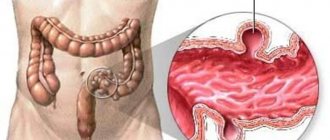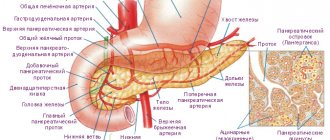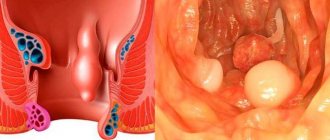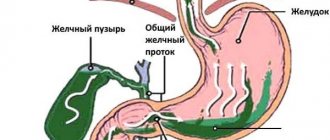Sigmoid colon cancer is a fairly commonly diagnosed disease in which the cancerous tumor is of epithelial origin. This type of colorectal cancer occurs in more than 30% of cases. The fundamental factors in the formation of the disease are considered to be poor nutrition and a sedentary lifestyle. However, there are other predisposing factors.
- Etiology
- Classification
- Symptoms
- Diagnostics
- Treatment
- Prevention and prognosis
The insidiousness of the disease is that it is asymptomatic. Characteristic symptoms occur in severe cases of the disease, when surgical treatment cannot be carried out. The main signs are pain and discomfort, changes in food preferences and an increase in the size of the abdomen.
To make a correct diagnosis, instrumental examinations are carried out, which are supplemented by laboratory studies and data obtained during an external examination of the patient.
Treatment is complex and includes surgery, chemotherapy and radiotherapy. The prognosis of sigmoid colon cancer depends on how timely medical care is provided.
In the international classification of diseases, such pathology is assigned its own value - ICD-10 code - C18.7.
Sigmoid colon cancer. What it is?
According to statistics, sigmoid colon cancer is considered the most common type of malignant tumors of the large intestine.
Sigmoid colon cancer is a tumor, most often formed from the epithelium of the mucous membrane (carcinoma). Due to improper nutrition in the human body, digestive disorders and the functioning of the entire intestine are possible. Often, fecal stagnation occurs in this section of the intestine, all due to decreased intestinal motility.
Stagnation of feces leads to intoxication of the body, the intestinal walls absorb toxins from the feces, and this in turn leads to unnatural growth of the epithelium. Epithelial proliferation is a direct factor in the formation of polyps or other types of precancerous diseases in the large intestine. Due to the slow blood circulation in the sigmoid colon, the tumor develops slowly, and the thick walls of the peritoneum muffle the symptoms of tumor formation and growth, which makes it a difficult type of cancer to diagnose.
Classification
The most important characteristic of a cancer tumor, which determines the clinical picture and influences the prognosis of the patient’s life, is the so-called Gleason index - the level of differentiation of abnormal cells.
Depending on the value of this indicator obtained from histological examination of tumor tissues, adenocarcinomas are divided into:
- highly differentiated;
- moderately differentiated;
- poorly differentiated;
- undifferentiated.
Highly differentiated
This type of sigmoid adenocarcinoma is a mildly aggressive tumor that is highly treatable.
Since the structure and properties of highly differentiated adenocarcinoma cells are almost identical to those of healthy tissues, they are characterized by a low level of pathogenicity - the ability to involve healthy cells in the tumor process.
Due to the increased size of the nuclei, tumor cells of highly differentiated neoplasms are clearly visible against the background of healthy tissue of the glandular epithelium lining the sigmoid colon from the inside.
Well-differentiated adenocarcinoma is characterized by slow growth and extremely rarely metastasizes; however, all tumors of this type are subject to mandatory surgical removal. Given their low-invasiveness, the treating specialist has the opportunity to perform surgical intervention at the most favorable moment for the patient.
When treating well-differentiated adenocarcinoma of the sigmoid colon, it is quite rare to resort to auxiliary therapeutic methods: radiotherapy and chemotherapy.
Despite the very low percentage of relapses, a patient (especially one at risk for this disease) who has undergone surgery to remove adenocarcinoma should remain under the closest supervision of the treating specialist.
Moderately differentiated
Cells of moderately differentiated adenocarcinoma have more pronounced differences from healthy epithelial cells, but they may not be enough to accurately determine the source of the pathological process.
The growth rate of moderately differentiated neoplasms of the sigmoid colon is not too great; the likelihood of metastases forming in the initial stages of the disease is equally insignificant.
However, one should not think that treatment of a moderately differentiated tumor can be carried out sparingly or postponed indefinitely: such a decision would be a great mistake, posing a direct threat to the life of the sick person, and here’s why:
- despite the relative (compared to poorly differentiated neoplasms) slow development of the pathological process, tumor growth still occurs;
- the risk of adenocarcinoma metastasis is quite high; The culprit for the occurrence of metastases may be the influence of provoking factors: external stress, concomitant diseases, old age, incorrect treatment tactics.
Poorly differentiated
The most aggressive type of adenocarcinoma of the sigmoid colon are tumors of a poorly differentiated type. Their rapid growth leaves no time for reflection and requires immediate medical action.
The main difficulty in the treatment of poorly differentiated adenocarcinomas is the practical impossibility of establishing the fault of which organ or tissue the tumor process began to develop. Equally difficult is the task of determining the boundaries of tumor areas merging with healthy epithelial tissues.
Poorly differentiated tumors of the sigmoid colon are prone to the formation of metastases, and even the operation itself to remove these malignant neoplasms can be the impetus for their appearance. That is why, despite the extreme danger of adenocarcinomas, their surgical removal is not always recommended.
We are talking about patients in whose body the growth of a low-grade neoplasm in the sigmoid colon occurs quite slowly, while surgery can provoke the spread of metastases throughout the body.
Before deciding on an operation to surgically remove poorly differentiated adenocarcinoma of the sigmoid colon, the attending specialist carefully analyzes the entire set of data about the patient: medical history, data from a complete medical examination, the presence of concomitant diseases, general health, possible contraindications to various types of treatment.
Leading clinics in Israel
Assuta
Israel, Tel Aviv
Ikhilov
Israel, Tel Aviv
Hadassah
Israel, Jerusalem
At this time, when the risk of cancer is high, the population is required to undergo a full examination, even without compelling reasons and severe symptoms.
Risk group
The occurrence of epithelial neoplasia of the sigmoid colon is due to various reasons:
- Heredity. It has been proven that patients who have close relatives with colon cancer have a high risk of acquiring this type of cancer;
- Polyps and polyposis. In terms of their properties, they are benign formations, but they tend to develop into malignant tumors;
- Diseases such as sigmoiditis, Crohn's disease, chronic colitis, etc.;
- Age. Sigmoid colon cancer is detected in patients aged about 40-60 years;
- Peristalsis disorder, constipation;
- Abuse of alcohol and carcinogenic products;
- Smoking;
- Diabetes mellitus type 2;
- Poor nutrition, with uncontrolled consumption of unhealthy fats and fast carbohydrates.
Causes
Predisposing factors for the development of the disease include:
- consumption of refined, high-calorie, low-fiber foods;
- obesity;
- sedentary lifestyle;
- smoking, alcohol;
- age over 60 years.
Despite the fact that a common understanding of the causes of malignant tumors of this localization has not yet been formed, a connection has been identified between the development of sigmoid colon cancer in people at risk.
- Presence of confirmed colon cancer in first-degree relatives. The chance of developing cancer in such individuals increases by 2-3 times.
- Hereditary intestinal diseases. First of all, this is familial adenomatous polyposis, against which, without appropriate treatment, a malignant tumor develops in 100% of cases.
- Polyps of the sigmoid colon. These are benign formations (adenomas) emanating from the mucous membrane. Polyps degenerate into cancer in 20-50% of cases. Almost always, carcinoma develops from a polyp, extremely rarely - from unchanged mucosa.
- Other precancerous intestinal lesions are ulcerative colitis, Crohn's disease, and sigmoiditis.
- Previously undergone operations for malignant intestinal tumors of other locations.
- Condition after treatment of malignant neoplasms of the breast and ovaries in women.
After fifty years, the risk of developing this cancer increases sharply.
- Features of the diet.
Increases the chance of getting sick by eating large amounts of meat products (beef, pork), refined foods and reducing the content of fiber and plant fibers in the menu.
The alkaline environment resulting from a large amount of meat products contributes to an increase in the growth of bacteria; decaying bile acids can have a carcinogenic effect on the mucous membrane of the digestive tract.
- Precancerous intestinal diseases.
Pathologies such as Crohn's disease, UC, adenomatous polyps, diffuse polyposis increase the risk of cancer and should attract increased attention from doctors, causing oncological alertness.
Cases of diagnosed cancer among close relatives or existing familial polyposis of the colon greatly increase the likelihood of developing this cancer.
- Physical inactivity and excess body weight.
A relationship has been identified between low levels of physical activity and excess weight: obese people are more likely to develop colon cancer.
The tendency to constipation contributes to the retention of feces and the accumulation of toxic substances, which increase the amount of carcinogens in the intestinal lumen.
Also, with excessive straining, the inner wall of the organ is mechanically injured, causing inflammation. If a patient has at least one of the above risk factors, he should be attentive to his health and be wary of cancer pathology.
For such patients after 40 years of age, it is recommended to undergo a colonoscopy and donate blood for tumor markers for preventive purposes.
Symptoms
Sigmoid colon cancer is dangerous because it has no obvious symptoms in the early stages, and these symptoms may be similar to less dangerous diseases. The symptoms of this cancer are the same in women and men.
In any case, you should pay attention to the following signs:
- Abnormal stool, when diarrhea gives way to constipation;
- Flatulence, irregular gas, rumbling in the stomach;
- Belching with an unpleasant odor;
- The urge to defecate is painful.
The presence of blood or blood clots in the stool can be mistaken for hemorrhoids, when this may indicate injury to a polyp that has already degenerated into a malignant formation. Dull pain appears in the second and third stages on the left in the iliac region, then the tumor grows into the intestinal wall.
With an incomplete examination of the patient, cancer is mistaken for an ulcer or an inflammatory process, such as pancreatitis, cholecystitis. To exclude diseases of another type, the doctor must carry out a differential diagnosis.
More obvious first symptoms that appear in later stages:
- Fatigue, fatigue;
- Chronic intoxication. These include: fever, nausea, dizziness, vomiting;
- Jaundice, enlarged liver;
- The skin becomes gray and earthy in tone;
- Anemia;
- Ascites (fluid in the abdominal region);
- Weight loss, loss of appetite;
- Bloating.
Symptoms
Tumors of varying degrees of differentiation have significant differences in the clinical picture. Sometimes there is a latent, that is, hidden flow. In this case, neoplasms are detected unexpectedly - for example, during an endoscopic examination of the intestine or during surgery for a completely different reason.
Benign tumors
Clinical manifestations can occur when tumors reach sizes of 1.5-2 cm or more in diameter. There may be several polyps, they tend to be located in groups. The risk of malignancy increases as the tissue grows.
Adenoma of the sigmoid colon or other benign tumor is manifested by symptoms such as:
- nagging pain in the abdomen;
- tenesmus (false urge to go to the toilet);
- secretion of mucus, less often blood with feces.
Sometimes there are complaints about bowel regularity and frequent constipation. With large tumors, there is a possibility of developing clinical intestinal obstruction. This condition is manifested by abdominal pain, nausea, bloating without passing gas and vomiting - including mixed with feces.
Diffuse polyposis of the colon
This is a hereditary (family) disease, which is considered precancerous - since 10-20 years after the onset of the pathological process there is a very high risk of malignancy. Multiple polyps formed by glandular epithelium appear on the mucous membrane of the colon, including the sigmoid colon (because of this, the process is also called adenomatosis).
A benign tumor of the sigmoid colon in the case of diffuse polyposis is characterized by the following manifestations:
- Abdominal pain.
- Intestinal bleeding.
- Frequent diarrhea.
- Heartburn.
- Belching.
- Discomfort in the epigastrium.
- Weakness, dizziness.
- Weight loss, exhaustion.
- Anemia.
Clinical manifestations are recorded in children aged 10-12 years (juvenile form) or in adolescents at the stage of puberty (proliferating type). There is a third option - Peutz-Jeghers syndrome (hamartoma). Along with the symptoms already listed in the list, one can also observe dark spots of pigmentation on the skin around the mouth, on the palms and cheeks, on the mucous membrane of the lips, and signs of polyposis are noted even in the newborn period.
Malignant formations
A description of cancer symptoms may include signs such as:
- pallor, weakness, progressive anemia;
- abdominal pain of varying severity;
- increased body temperature;
- alternating diarrhea and constipation;
- bloating, rumbling in the intestines;
- discharge from the rectum - mucous, bloody, putrefactive;
- nausea, vomiting, loss of appetite;
- feeling of heaviness in the epigastrium, belching;
- phenomena of intestinal obstruction.
Sometimes you can observe an atypical form, in which there are no complaints with a clearly palpable tumor. A completely different picture is typical for the so-called pseudo-inflammatory variant of the course. Patients experience a clinical picture of an “acute abdomen”: severe pain, muscle tension in the abdominal wall, high body temperature, signs of intoxication with an increase in leukocytosis during blood tests in the laboratory.
Complications
They are more typical and more common in malignant neoplasms, although an adverse effect of the differentiated structure (for example, with significant sizes or a large number of polyps) cannot be ruled out. A tumor of the sigmoid colon can be complicated by a number of conditions:
- Intestinal obstruction.
- Perforation of the tumor.
- Development of the inflammatory process.
- Bowel perforation.
- Bleeding.
- Invasion of organs and tissues (including as a result of metastasis).
Secondary complications associated with the spread of inflammation, intoxication and infection as a result of violation of the integrity of organs can be life-threatening. Heavy bleeding can also lead to anemia and shock.
Staging and prognosis
According to the worldwide classification of diseases, the ICD 10 code is C18.7.
The development of a malignant neoplasm of the sigmoid colon is divided into 4 stages:
Stage 1 . The tumor is located within the sigmoid colon. If detected at this stage, the survival rate is almost 100%.
Stage 2 . Divided into two subspecies.
- 2A , when the tumor occupies less than half the diameter of the intestine and grows inside the lumen;
- 2B , when the tumor grows into the wall of the sigmoid colon.
There are no metastases. The prognosis is good, the five-year survival rate in both cases is above 80 percent.
Stage 3 also consists of two options.
- 3A – The tumor occupies more than half the diameter of the intestine, without metastasis. Survival rate is about 60%;
- 3B – The tumor metastasizes to regional lymph nodes. Survival rate is about 40%.
Stage 4 . It is characterized by the growth of the tumor into neighboring organs, metastases in the lymph nodes and in distant organs. Chance of survival up to 10%.
Traditional methods of therapy
Treatment of intestinal cancer through the use of traditional methods complements surgery and chemotherapy. Traditional methods for treating a malignant tumor help strengthen the immune system, make you feel better after chemotherapy, normalize the functioning of the intestines, and prolong the patient’s life. Treatment with folk remedies and methods involves the use of:
- poisonous herbs;
- alcohol tinctures;
- soda, minerals, goji berries.
Complex therapy for cancerous tumors of the sigmoid colon provides a good chance for a successful and rapid recovery. Traditional antitumor drugs are part of complex therapy and help normalize well-being after surgery and a course of chemotherapy. It is important to remember that many herbs are highly poisonous, so strict adherence to the recipe for preparing the medicine is required.
Diagnostics
It is better to carry out diagnosis using all available methods, so as not to confuse cancer with diseases with similar symptoms. The simplest method is palpation. She also undergoes laboratory tests for tumor markers.
- Endoscopic examinations include colonoscopy or sigmoidoscopy. They are reliable, although painful, procedures. It should not be given to elderly or weak people, as there is a risk of intestinal perforation. During the examination, an endoscope inserted into the anus examines the sigmoid colon internally for the presence of a tumor and takes a sample of the tumor (biopsy);
- Irrigoscopy is a study in which a barium solution is injected into the patient’s body for further x-ray examination. Thanks to barium, which tends to coat the intestines, intestinal pathology is revealed;
- MRI will detect a tumor, determine its size, its location, as well as the presence of metastases in nearby and distant organs;
- Ultrasound of the abdominal cavity, both external and internal.
A biopsy of a section of the intestine will determine the composition of tumor cells and how differentiated the cancer is. Neoplasia may consist of glandular cells of a malignant nature (adenocarcinoma) or benign nature (adenoma).
Would you like to receive an estimate for treatment?
*Only upon receipt of data on the patient’s disease, a representative of the clinic will be able to calculate an accurate estimate for treatment.
Treatment
Treatment of malignant sigmoid colon blastomas combines surgical removal of the tumor and chemotherapy. Small tumors at the first or second stage can be removed without a skin incision using an endoscope.
Resection . Surgical removal of the tumor is a mandatory process in the treatment of sigmoid colon cancer. For small tumors, the tumor is removed along with the affected area and nearby lymph nodes. Next, the intestinal tube is connected and an anastomosis is performed.
At stage 4 of the disease, part of the intestine with the tumor is removed and a colostomy is performed.
Colostomy is the removal of the colon into an artificially created passage on the abdominal wall . The feces pass through the colon and end up in a colostomy bag. A colostomy can be made temporary or permanent. A temporary colostomy is performed to improve the condition of the body; after a few months, the colostomy is removed. If the rectum was removed along with the sigmoid colon, the colostomy will remain forever.
Prevention
- Early detection of precancerous conditions and initial forms of cancer. An annual stool test for occult blood for persons over 50 years of age, colonoscopy once every 5 years, for people with a hereditary predisposition - from 40 years of age.
- Removal of polyps larger than 1 cm, for smaller sizes - annual observation.
- Treatment of inflammatory bowel diseases.
- Minimizing avoidable risk factors - a diet enriched with fruits and vegetables, giving up bad habits, exercising, losing weight.
Forecast
The earlier cancer is detected and treatment is started, the higher the chances of a complete cure and saving life. It is known that highly differentiated malignant tumors respond better to treatment.
At the first and second stages, the forecasts are high, on average 90%. This is due to the fact that sigmoid colon cancer is not an aggressive form of cancer. At the third stage, depending on the presence of metastases in the body, the five-year survival rate ranges from 40-60%.
Clinical picture
Signs of intestinal cancer are determined by the location of the pathological focus. Colon cancer at the beginning of its development does not manifest itself with characteristic signs; only with a carefully collected history and complaints can one identify some general symptoms: health deteriorates, appetite and performance decrease. Other symptoms increase depending on the degree of the oncological process, complications, concomitant diseases, and the appearance of metastases.
Signs of intestinal cancer can be divided according to the pathogenetic mechanism underlying their development:
- Local manifestations are also called primary. They are caused by the presence of a tumor in the intestinal lumen.
- Secondary manifestations. They develop as the tumor grows, which causes obstruction and disruption of all functions of the digestive tract.
- When cancer grows into nearby organs or tissues, new symptoms appear. Complications or metastases complement the clinical picture of the disease.
- A cancer tumor affects the entire body as a whole, so the patient, in addition to local symptoms, also has general manifestations.
The first signs of a tumor are mainly of a general nature. They appear in the early stages, periodically disturbing the patient, but are not very pronounced, which becomes the reason for rarely seeking medical help. The initial manifestations are pathological impurities in the stool (blood and mucus). First, the blood appears in the form of streaks, single or multiple. The tumor grows and is more damaged by stool, which is why the volume of impurities in the stool increases. So, over time, dark or almost black blood appears mixed with feces. In some cases, blood precedes the act of defecation. Patients with advanced stages of the disease note the appearance of large blood clots that have a foul odor.
The next type of pathological impurity is mucus. The appearance of clear mucus in bowel cancer is rare. More often it is a mixture with bloody streaks, ichor, and in the later stages pus, a purulent-bloody liquid, is added to the mucus.
Such manifestations in a patient serve as a direct indication for performing a digital rectal examination of the rectum and prescribing sigmoidoscopy. If the patient has a history of hemorrhoids accompanied by bleeding, a chronic form of paraproctitis, a chronic or acute anal fissure, as well as other pathology of the perianal area, rectum with similar manifestations, the doctor should not refuse further examination, since these diseases are not a contraindication. A specialist should always remember the possibility of developing several diseases in one patient; this will help to detect the oncological process in time and begin treatment in the early stages.
Further growth of the tumor causes an increase in local symptoms. Blood is released in a large volume, takes the form of clots, but a typical difference is the absence of profuse bleeding (there is no stream of blood). The presence of a tumor causes a change in the shape of stool. It can become ribbon-like, and the patient feels a foreign body in the rectum.
Diet for sigmoid colon cancer and postoperative period
After the operation, the patient is required to follow a certain diet.
The first day is limited to fasting. The patient receives nutrients intravenously. In the next week, any solid food is contraindicated. You can only consume broths, puree soups, decoctions and juices. However, a specific list of permitted products should be obtained from your doctor. After 10 days, you can introduce fermented milk products, lean meat or lean fish into your diet. Prohibited products include:
- Any pickles, canned marinades;
- Fatty and fried meat dishes;
- Any types of smoked meats and sausages;
- Sweet bakery products and freshly baked bread;
- Coffee, chocolate;
- Alcohol and carbonated drinks;
- Full-fat milk and cheese;
- Eggs;
- Vegetables with coarse fiber, bran;
- Legumes.
Allowed foods are best steamed or boiled. It is better to divide the portions into 5 or 6 small parts. The diet after resection should be low-fat, and the consumption of foods that cause gas and bloating should be reduced.
You should not rely on treatment with folk remedies. Proper nutrition should help quickly restore digestion and restore strength and energy after chemotherapy.
Preventive measures include reducing the consumption of harmful carcinogenic foods, normalizing peristalsis, and curing constipation. If any inflammatory processes are present, they must be completely cured. And of course, timely examination and diagnosis, especially for people who have a predisposition to this disease.
Diet
For a malignant neoplasm localized in the intestinal area, the patient is prescribed fractional meals 5-6 times a day. Dishes are served exclusively warm and ground.
The diet after surgery consists exclusively of juices, liquid vegetable purees and herbal decoctions. This diet must be maintained for 5-6 days. The consumption of any food products must be strictly coordinated with the doctor. The subsequent diet for malignant neoplasms implies a reduction in the amount of meat consumed or its complete exclusion, fried foods, canned food, confectionery, and semi-finished products. It is imperative to exclude spicy and hard foods from your usual diet.
You need to consume only natural fresh foods, in particular vegetables, fruits and cereals. Nutrition should be balanced, complete, and not contain gross inclusions. It is best to consume as many light meals as possible. After a month, you can gradually include lean varieties of meat and fish, and various fermented milk products in your diet.











